

| While for the past 300 years the violin has been built in curly maple and spruce for their resonance tables, accessories however, have known more variety. Their mechanical function requires strong resistance to traction (for tailpieces), to torsion (for pegs), or to wear (finger-board).
Prior to industrial and colonial era, European woods, hard with fine grain, such as apple and plum trees, were used. Some are naturally "fat" and, thanks to their fine grain, a perfect polish can be obtained. Rowan-tree (Sorbus domestica) is another wild fruit tree, very hard and resistant; it was used in planing or mill gears. |
 Century-old Pine | |
| In Mediterranean countries, the slow growing vegetation (Garrigue) has been used in arts and crafts; such as chests (glasses cases, combs, sewing kits…). It often took more than a century to grow the diameter size of a bottle. Later, ebony became a colonial resource. This very hard, black wood comes from Africa, Madagascar or India. Its exceptional qualities surpass most of our European woods. Originally used in fine veneer (heavy and costly at the use), we have now come to utilise it for the body part. Indeed, since the 19th century, violin strings are more stretched, in order to get a more powerful sonority; as a result, accessories are heavier, which is certainly prejudicial to rich sound. | ||
This trend for black, a characteristic of the Napoleonian 2nd Empire - Victorian times- marks the end of the 19th century. It expresses the rigid and puritan culture of the first industrial revolution. The dark accessories, visible on the instrument, bring out the purity of its lines. Its stiffness is in opposition to the glaring and multicolour baroque of the two previous centuries. It is the end of carved faces in place of wreaths, with lots of adornments and marquetries, such as the "Hellier" which was Stradivarius' violin in 1679. |
 the Hellier, Stradivarius the Hellier, Stradivarius | |
| On the other hand, from Holland to Switzerland, the Germanic taste tends to prefer ebony until today. Hill House in England has adopted boxwood for its best-looking instruments.
It is well known that Italy plays a fundamental role in violin making. Their Roman ancestors brought boxwood all the way to England for their religious activities. If we owe the violin to the Italy, we also owe them the origin of the English taste for accessories in Boxwood. More recently, we must note the use of Pernambuco in tailpiece making; it is a kind of Brazilian acacia used by bow makers. First known as a tinctorial wood (red/purple) by Mirecourt drapers, a bow maker discovered its elasticity and rigidity for the best bow sticks. | ||
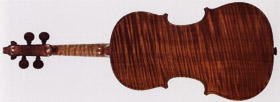 Back of a Rocca |
Curly wood Curled, or flamed woods are used in violin making. Certainly, we can appreciate the beauty of undulations in the wood, but also its acoustic. As in the case of corrugated metal sheet, the wood waves make the instrument vault rigid in its width. This increases that much more sound transmission. |
|
 |
|
|
Undulated wood They are more difficult to work on; we therefore see them much less in cabinet making, that on old furniture, such as maple, poplar, walnut and ash. We still do not know the origin of this wood property. |
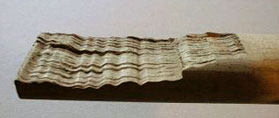 Broken axe handle in curly ash wood | |
Boxwood: Always green (Buxus Sempervirens) box tree is a Mediterranean shrub. Barely big as a bottle in diameter, it takes 150 years to come to maturity. It is one of the finest and harder European woods. Of a nice yellow colour and easy to work on for sculptors and turners, it will be used in many delicate moulding, ending up looking like marble.
Has been used, since Roman era - or before- for magical, ritual or medicinal purposes, as well as for many domestic items. A very rare and important wood. It used to be the favourite material in an industry that has disappeared, "la tabletterie". It includes the fabrication of kitchen utensils, the art of the table, sewing kits, chests and cases, game parts, tools and handles, musical instruments… It is easy to understand how important this trade "of all trades" was at the time, when we see what the industrial era has brought us: Metal (or plastic) fabrication that is accurate, fast and automated. Today these items are affordable, and easily replaced. Boxwood use is rare: games (chess) and a few precision tools. The return to baroque music has reintroduced this wood: flutes and violin accessories in boxwood are considered of optimum quality. |
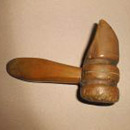 Hammer for straw-bottoming chairs... 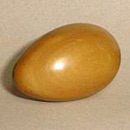 Mending egg 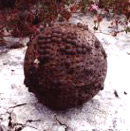 Petanque ball |
|
| For Bois d'Harmonie, boxwood is of cardinal importance. This local wood is found in middle mountain areas, far from access. These trees must be cut at the end of autumn, after full moon, before snow falls: That is when its sap is at its lowest, thus easier to dry. Since it grows on limey cliffs, difficult in access, it will be carried on people's back. Placed in a cellar, it will dry slowly and set for 10 years before being used. Fortunately, it is not an endangered species. Traditional exploitation has ceased, and allows very nice specimens to develop, particularly in zones difficult to access. In plains, it is considered as an invading nuisance, while, with the oak, it indicates the first signs of newforestation. | ||